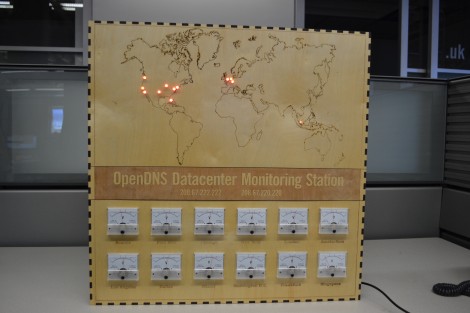
Nothing says Cold War like a map of the work with LEDs embedded in it. Throw in some analog dials for good measure and you’ve got a piece that would be comfortable mounted next the WOPR in everyone’s favorite ’80s-computers-run-amok movie. We think [Dima] really hit the mark when building this status panel for OpenDNS datacenter monitoring.
[Dima] works for OpenDNS and wanted to make something special for its upcoming 5 year anniversary. He’d already been toying with making boxes from laser-cut wooden pieces. This was just a matter of choosing a size that would fit the dials and leave a suitable area for a laser-etched map. Each of the twelve panel meters gets a PWM signal from the Arduino Mega that he used to bring the device to life. It shows a comparative server load for each data center based on the previous day’s numbers. There is an LED in the map for each of these centers. Right now they’re all red, but he used RGB LEDs and plans to upgrade the capability soon. He should have no problem doing this as he sourced some TLC5940 drivers to extend his I/O capabilities.
Don’t forget the check out the clip embedded after the break.
[youtube=http://www.youtube.com/watch?v=lf-T4aCyWHE&w=470]














Map of the work should be ma of the world
Woops ment map
Win
This is a great display and the RGB LEDs will add another dimension of coolness.
That said, it is nothing like War Games which used vector graphics on the display screens. The WOPR itself was mostly lights and a small LCD display. I think it’s time I lent you my DVD, Mike!
Now build Joshua so we can play some Global Thermonuclear War!
That is awesome! I want one :)
Why use TLC5940s? I’m assuming he wants the LEDs to all have various brightness, but the mega has 40 digital I/O pins (not including the 14 PWM pins). There are 12 RGB LEDs to control, so you don’t even need to multiplex/charlieplex them if you don’t want to. Just whip up some interrupt driven PWM or BAM code to implement varying intensity in software and you’re good to go without any extra hardware.
@pedro: The LEDs do have individual variable brightness.
Software PWM is a great idea and might be worth playing with for the next project. The mega is being swapped out for an Uno as soon as I get some time :)
@Mike M: There is a game that lets you play Global Thermonuclear War called DEFCON. http://www.everybody-dies.com/
Pretty cool. The voltmeters always make awesome displays.
The map distortion is quite bothersome though, Greenland looks like it is 2/3 the size of Africa while it’s actually about 1/14 -.-
Looks like a cylindrical projection, probably Miller or Mercator. It gives accurate positioning but not all scales/distances are correct. There is serious distortion near the poles.
http://en.wikipedia.org/wiki/Map_projection
WOPR approves of this hack.
Yup, they were all about LEDs back during the cold war. ;)
When that movie was popular people actually got calls from modems that were dialing random numbers to see if it was a computer, and it would screech very loudly.
And of course most average people had no clue what it was so it was pretty alarming AND annoying to them I understand.